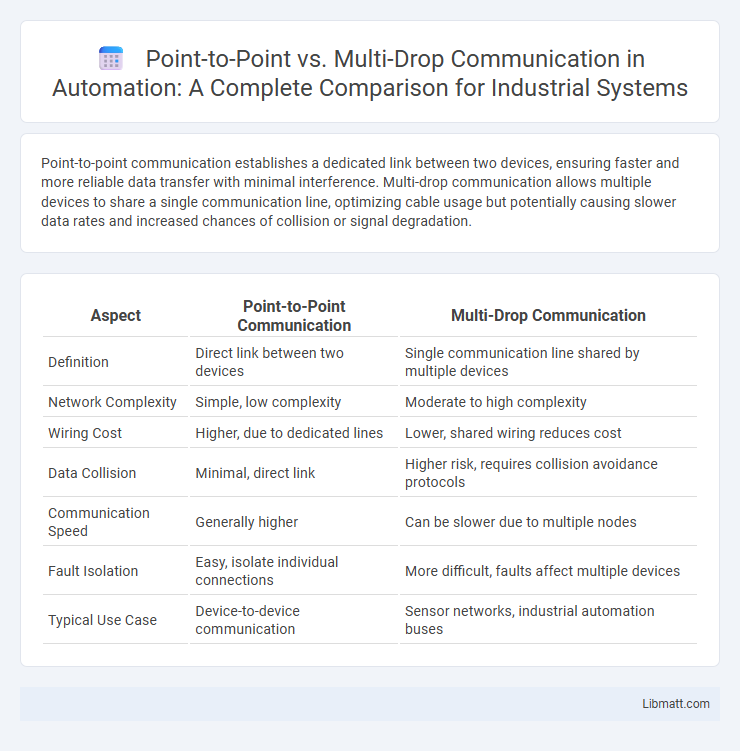Point-to-point communication establishes a dedicated link between two devices, ensuring faster and more reliable data transfer with minimal interference. Multi-drop communication allows multiple devices to share a single communication line, optimizing cable usage but potentially causing slower data rates and increased chances of collision or signal degradation.
Table of Comparison
| Aspect | Point-to-Point Communication | Multi-Drop Communication |
|---|---|---|
| Definition | Direct link between two devices | Single communication line shared by multiple devices |
| Network Complexity | Simple, low complexity | Moderate to high complexity |
| Wiring Cost | Higher, due to dedicated lines | Lower, shared wiring reduces cost |
| Data Collision | Minimal, direct link | Higher risk, requires collision avoidance protocols |
| Communication Speed | Generally higher | Can be slower due to multiple nodes |
| Fault Isolation | Easy, isolate individual connections | More difficult, faults affect multiple devices |
| Typical Use Case | Device-to-device communication | Sensor networks, industrial automation buses |
Overview of Point-to-Point and Multi-Drop Communication
Point-to-Point communication involves a dedicated connection between two devices, enabling direct and reliable data transfer with minimal interference. Multi-Drop communication allows multiple devices to share a single communication line, optimizing resource usage but requiring complex addressing and arbitration protocols. Understanding these methods helps you choose the right setup for efficient data exchange in networked systems.
Key Differences Between Point-to-Point and Multi-Drop
Point-to-point communication involves a direct connection between two devices, ensuring dedicated bandwidth and faster data transfer rates, while multi-drop communication links multiple devices on a single bus, sharing bandwidth and potentially causing data collisions. You will notice point-to-point provides better reliability and security due to isolated channels, whereas multi-drop systems offer cost-efficiency and simpler wiring for connecting several devices. Understanding these key differences helps optimize network design based on performance needs and device quantity.
Architecture and Topology Comparison
Point-to-point communication features a dedicated direct link between two devices, ensuring high-speed, low-latency data transfer with minimal interference, ideal for secure and reliable connections. Multi-drop communication uses a shared bus architecture where multiple devices connect along a single communication line, optimizing resource usage but introducing potential contention and reduced data rates. The point-to-point topology is typically linear with separate links, while multi-drop employs a bus topology that supports multiple devices on one line, influencing network design and performance scalability.
Performance and Data Transmission Efficiency
Point-to-point communication offers higher performance and data transmission efficiency by dedicating a single communication line between two devices, reducing data collision and latency. Multi-drop communication allows multiple devices to share the same line, which can introduce delays and lower throughput due to bus arbitration and increased signal degradation. Your choice should consider these trade-offs to optimize system responsiveness and bandwidth utilization.
Scalability and Flexibility Factors
Point-to-point communication offers high reliability and dedicated bandwidth, but its scalability is limited as each device requires a direct connection, increasing complexity and cost. Multi-drop communication supports adding multiple devices on a single communication line, enhancing flexibility and reducing wiring requirements, yet this can introduce data collisions and slower overall transmission speeds. Your choice between these methods depends on the need for scalable expansion or flexible, cost-effective networking.
Reliability and Fault Tolerance
Point-to-point communication offers higher reliability by establishing a dedicated link between two devices, minimizing interference and data collision. Multi-drop communication can experience reduced fault tolerance as multiple devices share the same communication line, increasing the risk of errors if one node fails or generates noise. Implementing error detection and retransmission protocols is essential in multi-drop systems to maintain data integrity and improve resilience.
Cost Implications and Resource Requirements
Point-to-Point communication requires dedicated lines for each device pair, leading to higher infrastructure costs and increased complexity in wiring. Multi-Drop communication reduces cabling expenses by sharing a single communication line among multiple devices, but demands more sophisticated protocols and resource management to prevent data collisions. Resource allocation in multi-drop setups often involves additional processing power and time for addressing and arbitration, while point-to-point offers simpler resource management at the expense of scalability.
Common Use Cases in Industry
Point-to-point communication is commonly used in industrial automation systems where dedicated, high-reliability links are necessary, such as connecting sensors to controllers or safety systems in manufacturing plants. Multi-drop communication is favored in environments requiring cost-effective wiring and scalability, like building automation networks and smart grid monitoring, where multiple devices share a single communication line. Industries prioritize point-to-point setups for critical control tasks and multi-drop configurations for expansive sensor networks and distributed data collection.
Security Considerations for Each Method
Point-to-point communication offers enhanced security due to its direct link between two devices, minimizing the risk of data interception or unauthorized access. Multi-drop communication involves multiple devices sharing the same communication line, increasing vulnerability to eavesdropping and potential data breaches if proper encryption and authentication measures are not implemented. You should assess the security protocols tailored for each method to ensure data integrity and confidentiality.
Selecting the Right Communication Model for Applications
Choosing the right communication model between point-to-point and multi-drop depends on application requirements such as data volume, device count, and latency tolerance. Point-to-point communication offers dedicated, low-latency connections ideal for critical real-time systems or high-bandwidth needs, while multi-drop communication efficiently supports multiple devices on a single bus, optimizing cost and complexity in sensor networks and industrial automation. Evaluating factors like network scalability, fault tolerance, and synchronization demands ensures optimal performance and resource utilization in embedded systems and IoT deployments.
Point-to-Point vs Multi-Drop Communication Infographic

 libmatt.com
libmatt.com